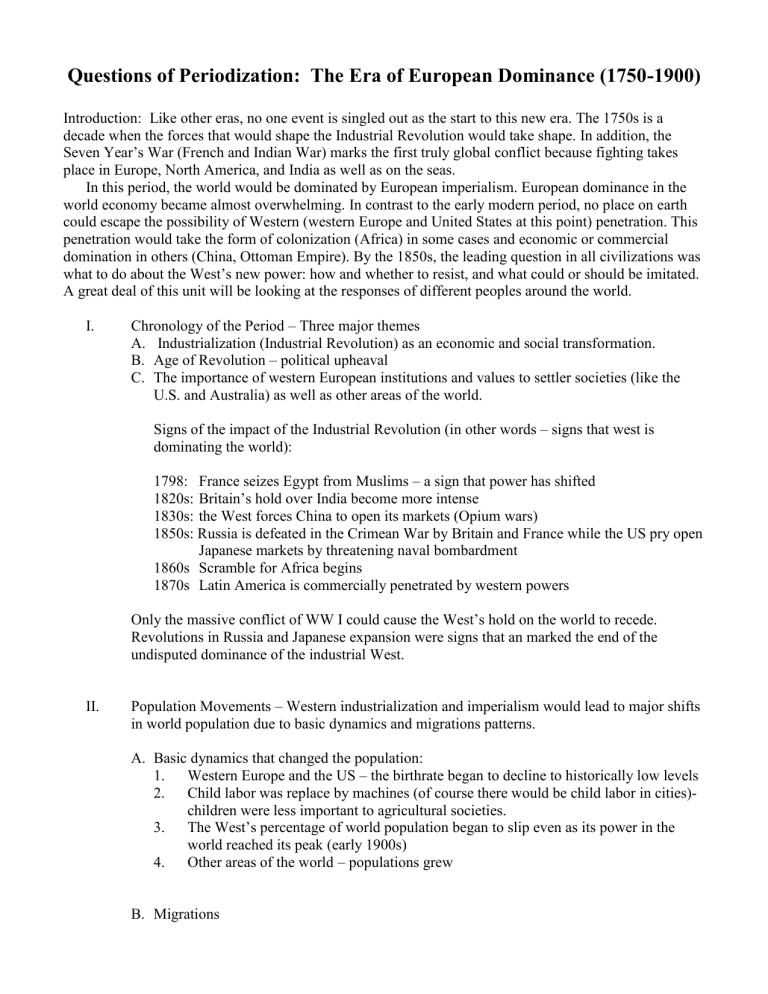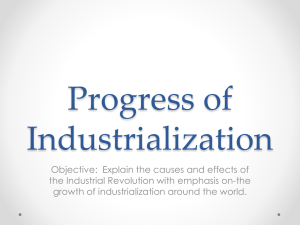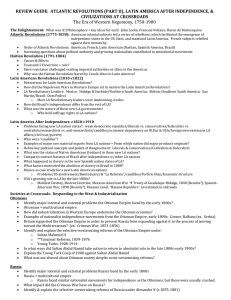Questions of Periodization: The Era of European Dominance (1750-1900)

Questions of Periodization: The Era of European Dominance (1750-1900)
Introduction: Like other eras, no one event is singled out as the start to this new era. The 1750s is a decade when the forces that would shape the Industrial Revolution would take shape. In addition, the
Seven Year’s War (French and Indian War) marks the first truly global conflict because fighting takes place in Europe, North America, and India as well as on the seas.
In this period, the world would be dominated by European imperialism. European dominance in the world economy became almost overwhelming. In contrast to the early modern period, no place on earth could escape the possibility of Western (western Europe and United States at this point) penetration. This penetration would take the form of colonization (Africa) in some cases and economic or commercial domination in others (China, Ottoman Empire). By the 1850s, the leading question in all civilizations was what to do about the West’s new power: how and whether to resist, and what could or should be imitated.
A great deal of this unit will be looking at the responses of different peoples around the world.
I.
Chronology of the Period – Three major themes
A. Industrialization (Industrial Revolution) as an economic and social transformation.
B. Age of Revolution – political upheaval
C. The importance of western European institutions and values to settler societies (like the
U.S. and Australia) as well as other areas of the world.
Signs of the impact of the Industrial Revolution (in other words – signs that west is dominating the world):
1798: France seizes Egypt from Muslims – a sign that power has shifted
1820s: Britain’s hold over India become more intense
1830s: the West forces China to open its markets (Opium wars)
1850s: Russia is defeated in the Crimean War by Britain and France while the US pry open
Japanese markets by threatening naval bombardment
1860s Scramble for Africa begins
1870s Latin America is commercially penetrated by western powers
Only the massive conflict of WW I could cause the West’s hold on the world to recede.
Revolutions in Russia and Japanese expansion were signs that an marked the end of the undisputed dominance of the industrial West.
II.
Population Movements – Western industrialization and imperialism would lead to major shifts in world population due to basic dynamics and migrations patterns.
A. Basic dynamics that changed the population:
1. Western Europe and the US – the birthrate began to decline to historically low levels
2. Child labor was replace by machines (of course there would be child labor in cities)- children were less important to agricultural societies.
3. The West’s percentage of world population began to slip even as its power in the world reached its peak (early 1900s)
4. Other areas of the world – populations grew
B. Migrations
1. Immigration – Caused by industrialization of the West – drew workers from agricultural regions to urban centers a. southern and eastern Europeans would emigrate to Germany, France and the US b. Italian, Spanish and Portuguese immigrants went to prosperous Latin America in the late 1800s c. the slave trade from Africa was ended in the early 1800s – only a trickle continued and mainly in the Middle East. This occurred because of Humanitarian considerations and the ability of factories to organize free workers more effectively d. Immigrants from Asia and Europe were recruited to replace slaves (and their treatment was not much better than that of slaves)
III. Diversity in the Age of Western Dominance – industrialization and imperialist expansion were not the only major developments of the period.
A. Popular conversion to Islam began in sub-Saharan Africa in the late 1700s that changed the continent’s religious map.
B. Latin American nations, after getting its independence, started a new round of nation building.
C. China would see social unrest in the mid 1800s that involved the peasants rising against the power of unchecked landlords (thus repeating what typically happened every time a
Chinese dynasty declined)
D. Diverse reactions to the West’s military and industrial might – these different reactions would lead to new economic inequalities in different areas of the world
1. Incorporation into an expanded Western civilization a. United States b. Australia c. New Zealand d. Canada
2. Internal change – both Russia and Japan imitated some important characterisitics of the West without becoming entirely Western (kind of like the “selective westernization of Peter the Great, except he wanted Russia to become Western and failed).
3. Indecision – China and the Ottomans both lost territory to the West but still remained mostly independent despite their growing weakness and outside interference
4. Colonization – applies to most of the rest of the world (except new nations of Latin
America). It is important to note that there were different degrees of colonization.
IV. Major Themes Transformed – Industrialization brought about the recasting of some major human themes in world history
A. Impact of Technology and demography on people and the environment - New machines and higher population densities (urban centers) intensified human ability to affect the environment, often for the worst.
1. chemical and smoke pollution
2. deforestation due to increased food needs
3. New modes of transportation and military pressure made isolation more difficult for any civilization. This brought about new forms of international relations (most independent countries would exchange diplomats), international agencies (Red Cross,
IOC)
B. Systems of social structure and gender structure
1. Economic and social inequality within societies increased with the spread of wage labor
2. On the other hand, forced labor systems (including slavery) were abolished in this period.
3. Legal equality increased
4. Gender relations continued to vary between societies a. Machines and male labor replaced or devalued women’s work in many places b. world-wide increase of female domestic servants




